INFINITI QX60-HYBRID 2016 Owners Manual
Manufacturer: INFINITI, Model Year: 2016, Model line: QX60-HYBRID, Model: INFINITI QX60-HYBRID 2016Pages: 623, PDF Size: 12.97 MB
Page 361 of 623
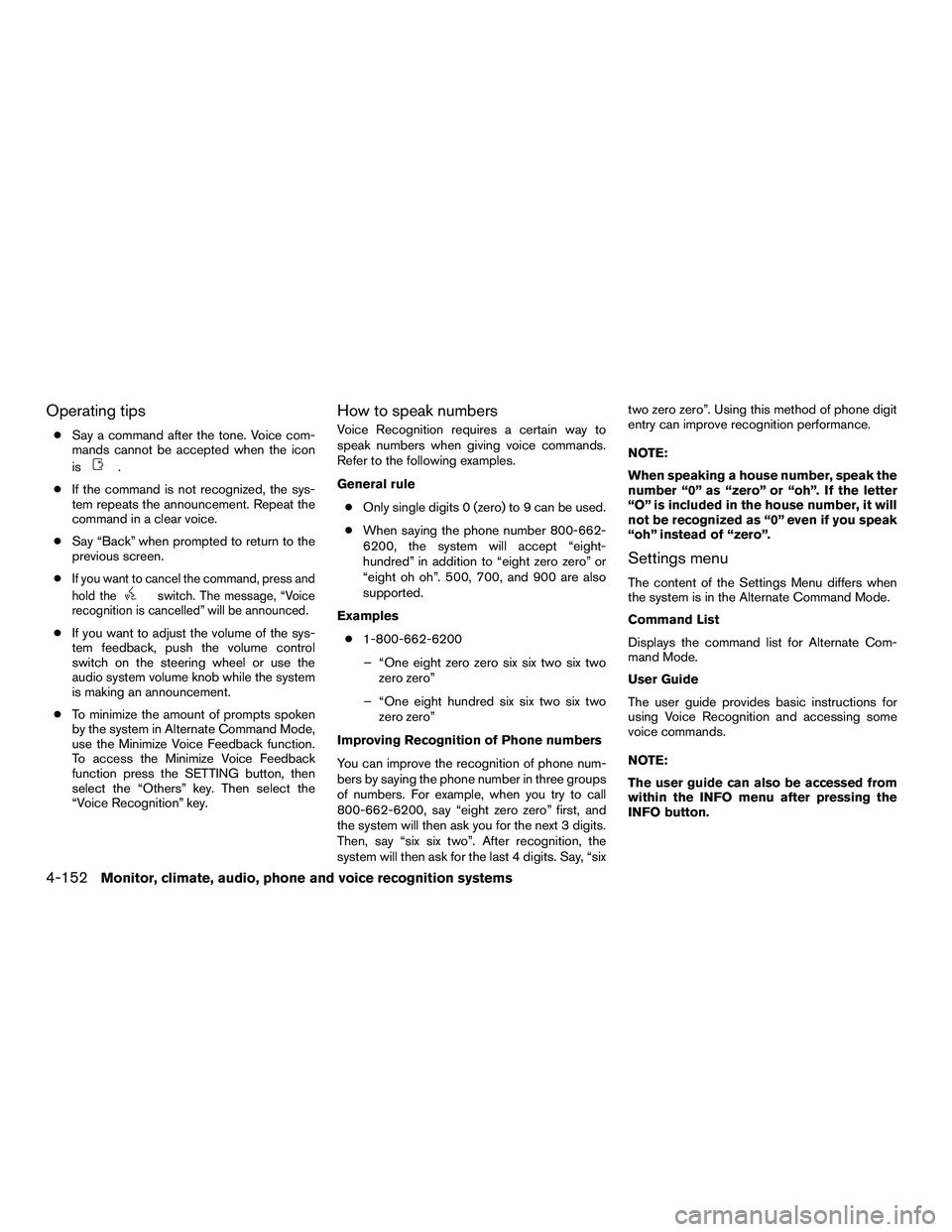
Operating tips
●Say a command after the tone. Voice com-
mands cannot be accepted when the icon
is
.
● If the command is not recognized, the sys-
tem repeats the announcement. Repeat the
command in a clear voice.
● Say “Back” when prompted to return to the
previous screen.
●
If you want to cancel the command, press and
hold the
switch. The message, “Voice
recognition is cancelled” will be announced.
● If you want to adjust the volume of the sys-
tem feedback, push the volume control
switch on the steering wheel or use the
audio system volume knob while the system
is making an announcement.
● To minimize the amount of prompts spoken
by the system in Alternate Command Mode,
use the Minimize Voice Feedback function.
To access the Minimize Voice Feedback
function press the SETTING button, then
select the “Others” key. Then select the
“Voice Recognition” key.
How to speak numbers
Voice Recognition requires a certain way to
speak numbers when giving voice commands.
Refer to the following examples.
General rule
● Only single digits 0 (zero) to 9 can be used.
● When saying the phone number 800-662-
6200, the system will accept “eight-
hundred” in addition to “eight zero zero” or
“eight oh oh”. 500, 700, and 900 are also
supported.
Examples ● 1-800-662-6200
– “One eight zero zero six six two six two zero zero”
– “One eight hundred six six two six two zero zero”
Improving Recognition of Phone numbers
You can improve the recognition of phone num-
bers by saying the phone number in three groups
of numbers. For example, when you try to call
800-662-6200, say “eight zero zero” first, and
the system will then ask you for the next 3 digits.
Then, say “six six two”. After recognition, the
system will then ask for the last 4 digits. Say, “six two zero zero”. Using this method of phone digit
entry can improve recognition performance.
NOTE:
When speaking a house number, speak the
number “0” as “zero” or “oh”. If the letter
“O” is included in the house number, it will
not be recognized as “0” even if you speak
“oh” instead of “zero”.
Settings menu
The content of the Settings Menu differs when
the system is in the Alternate Command Mode.
Command List
Displays the command list for Alternate Com-
mand Mode.
User Guide
The user guide provides basic instructions for
using Voice Recognition and accessing some
voice commands.
NOTE:
The user guide can also be accessed from
within the INFO menu after pressing the
INFO button.
4-152Monitor, climate, audio, phone and voice recognition systems
Page 362 of 623
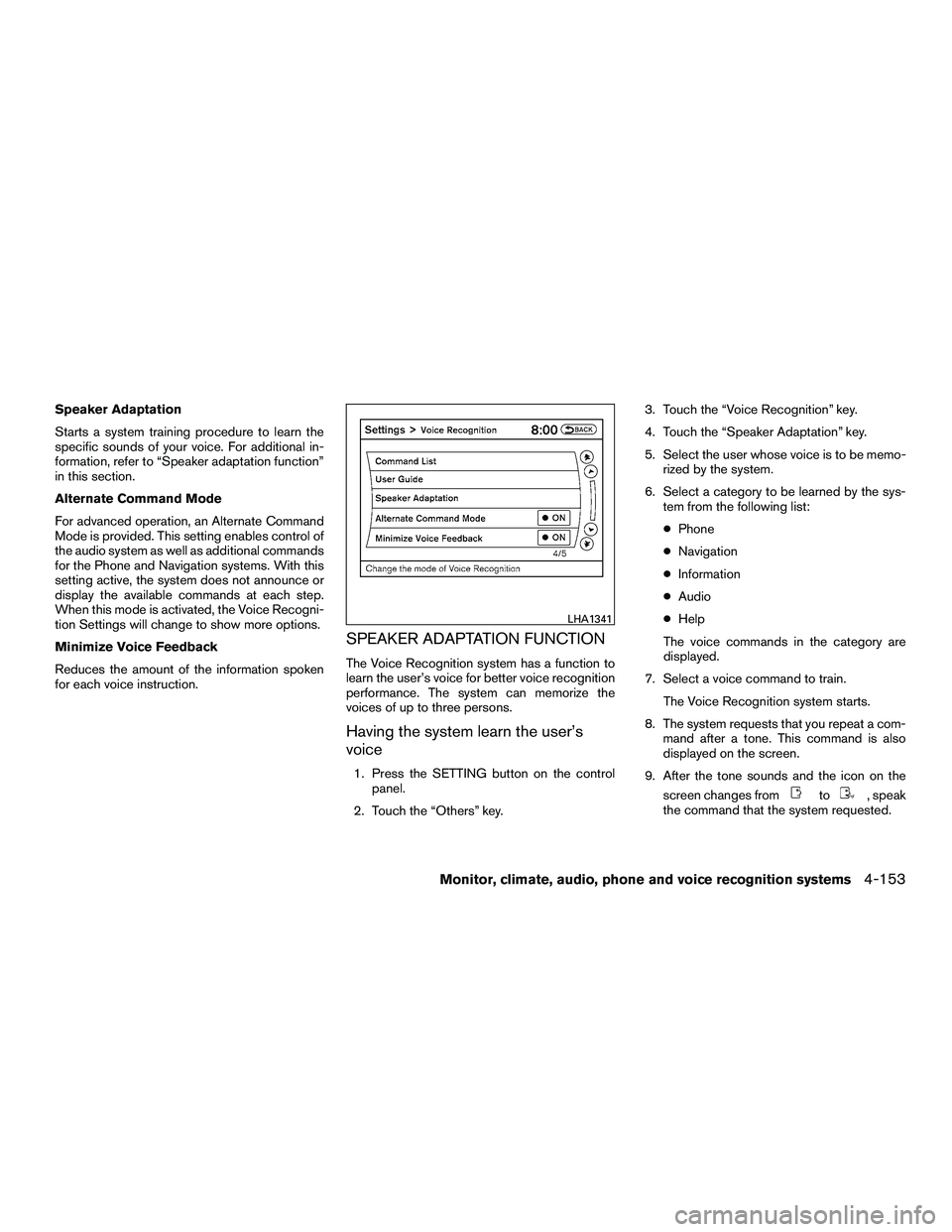
Speaker Adaptation
Starts a system training procedure to learn the
specific sounds of your voice. For additional in-
formation, refer to “Speaker adaptation function”
in this section.
Alternate Command Mode
For advanced operation, an Alternate Command
Mode is provided. This setting enables control of
the audio system as well as additional commands
for the Phone and Navigation systems. With this
setting active, the system does not announce or
display the available commands at each step.
When this mode is activated, the Voice Recogni-
tion Settings will change to show more options.
Minimize Voice Feedback
Reduces the amount of the information spoken
for each voice instruction.
SPEAKER ADAPTATION FUNCTION
The Voice Recognition system has a function to
learn the user’s voice for better voice recognition
performance. The system can memorize the
voices of up to three persons.
Having the system learn the user’s
voice
1. Press the SETTING button on the controlpanel.
2. Touch the “Others” key. 3. Touch the “Voice Recognition” key.
4. Touch the “Speaker Adaptation” key.
5. Select the user whose voice is to be memo-
rized by the system.
6. Select a category to be learned by the sys- tem from the following list:
● Phone
● Navigation
● Information
● Audio
● Help
The voice commands in the category are
displayed.
7. Select a voice command to train. The Voice Recognition system starts.
8. The system requests that you repeat a com- mand after a tone. This command is also
displayed on the screen.
9. After the tone sounds and the icon on the screen changes from
to, speak
the command that the system requested.
LHA1341
Monitor, climate, audio, phone and voice recognition systems4-153
Page 363 of 623
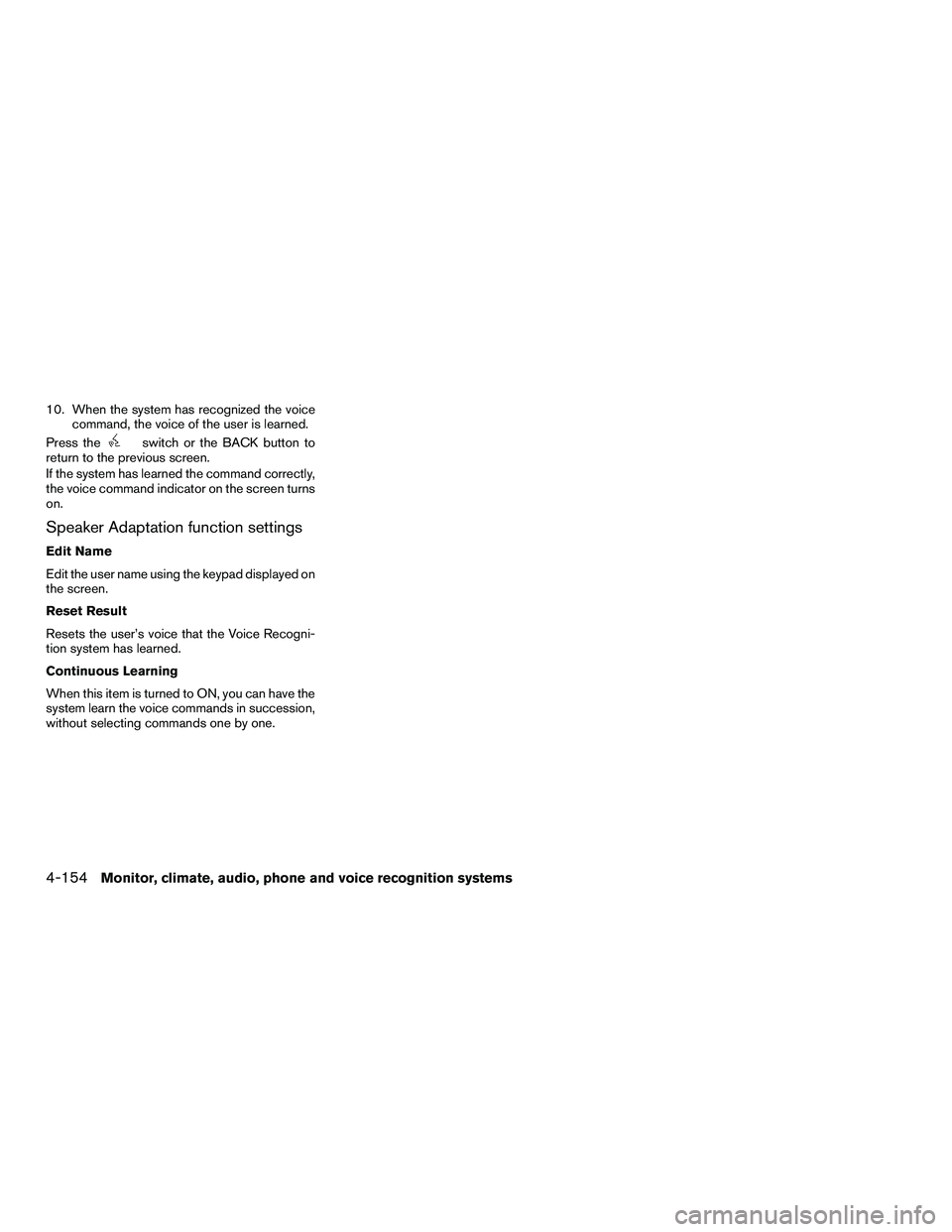
10. When the system has recognized the voicecommand, the voice of the user is learned.
Press the
switch or the BACK button to
return to the previous screen.
If the system has learned the command correctly,
the voice command indicator on the screen turns
on.
Speaker Adaptation function settings
Edit Name
Edit the user name using the keypad displayed on
the screen.
Reset Result
Resets the user’s voice that the Voice Recogni-
tion system has learned.
Continuous Learning
When this item is turned to ON, you can have the
system learn the voice commands in succession,
without selecting commands one by one.
4-154Monitor, climate, audio, phone and voice recognition systems
Page 364 of 623
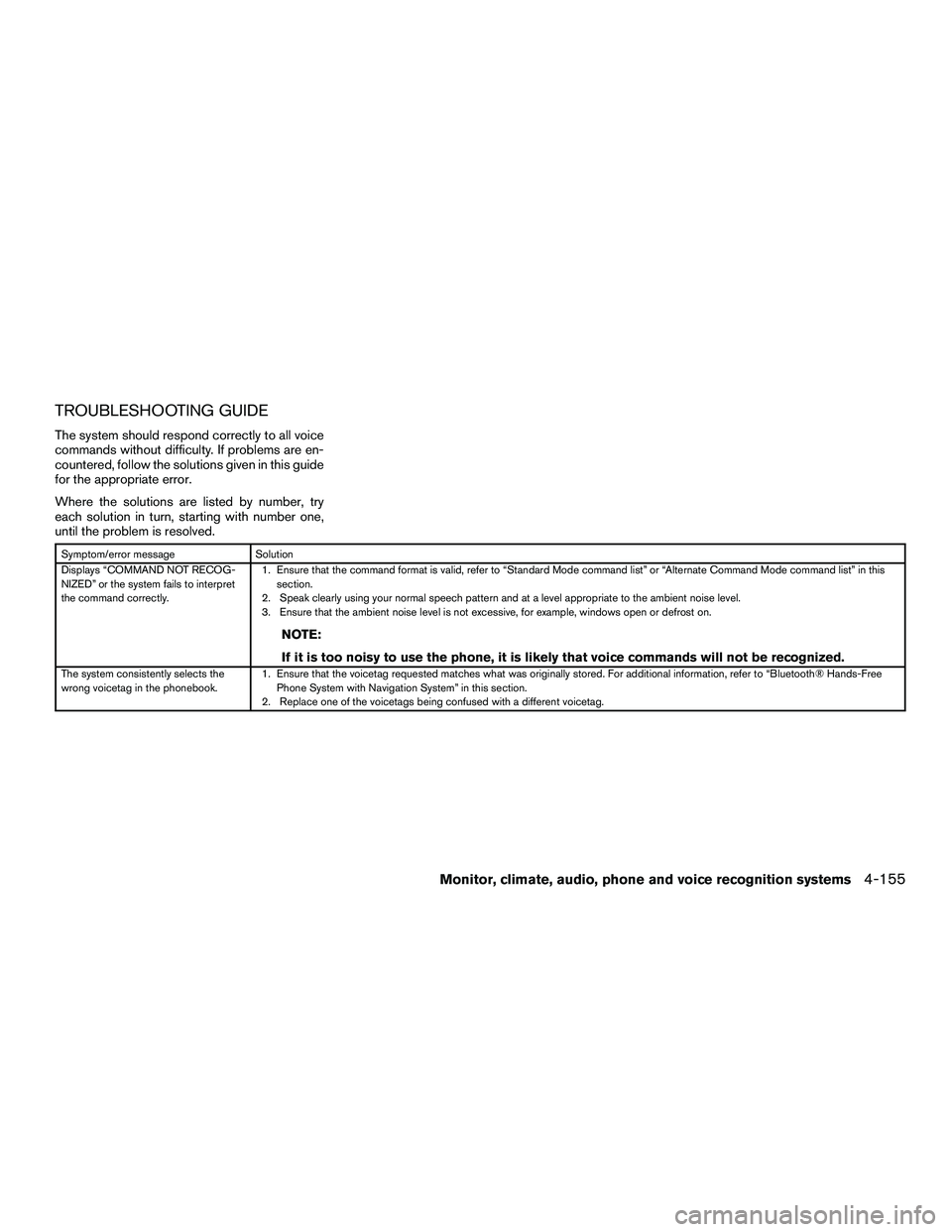
TROUBLESHOOTING GUIDE
The system should respond correctly to all voice
commands without difficulty. If problems are en-
countered, follow the solutions given in this guide
for the appropriate error.
Where the solutions are listed by number, try
each solution in turn, starting with number one,
until the problem is resolved.
Symptom/error messageSolution
Displays “COMMAND NOT RECOG-
NIZED” or the system fails to interpret
the command correctly. 1. Ensure that the command format is valid, refer to “Standard Mode command list” or “Alternate Command Mode command list” in this
section.
2. Speak clearly using your normal speech pattern and at a level appropriate to the ambient noise level.
3. Ensure that the ambient noise level is not excessive, for example, windows open or defrost on.
NOTE:
If it is too noisy to use the phone, it is likely that voice commands will not be recognized.
The system consistently selects the
wrong voicetag in the phonebook. 1. Ensure that the voicetag requested matches what was originally stored. For additional information, refer to “Bluetooth® Hands-Free
Phone System with Navigation System” in this section.
2. Replace one of the voicetags being confused with a different voicetag.
Monitor, climate, audio, phone and voice recognition systems4-155
Page 365 of 623
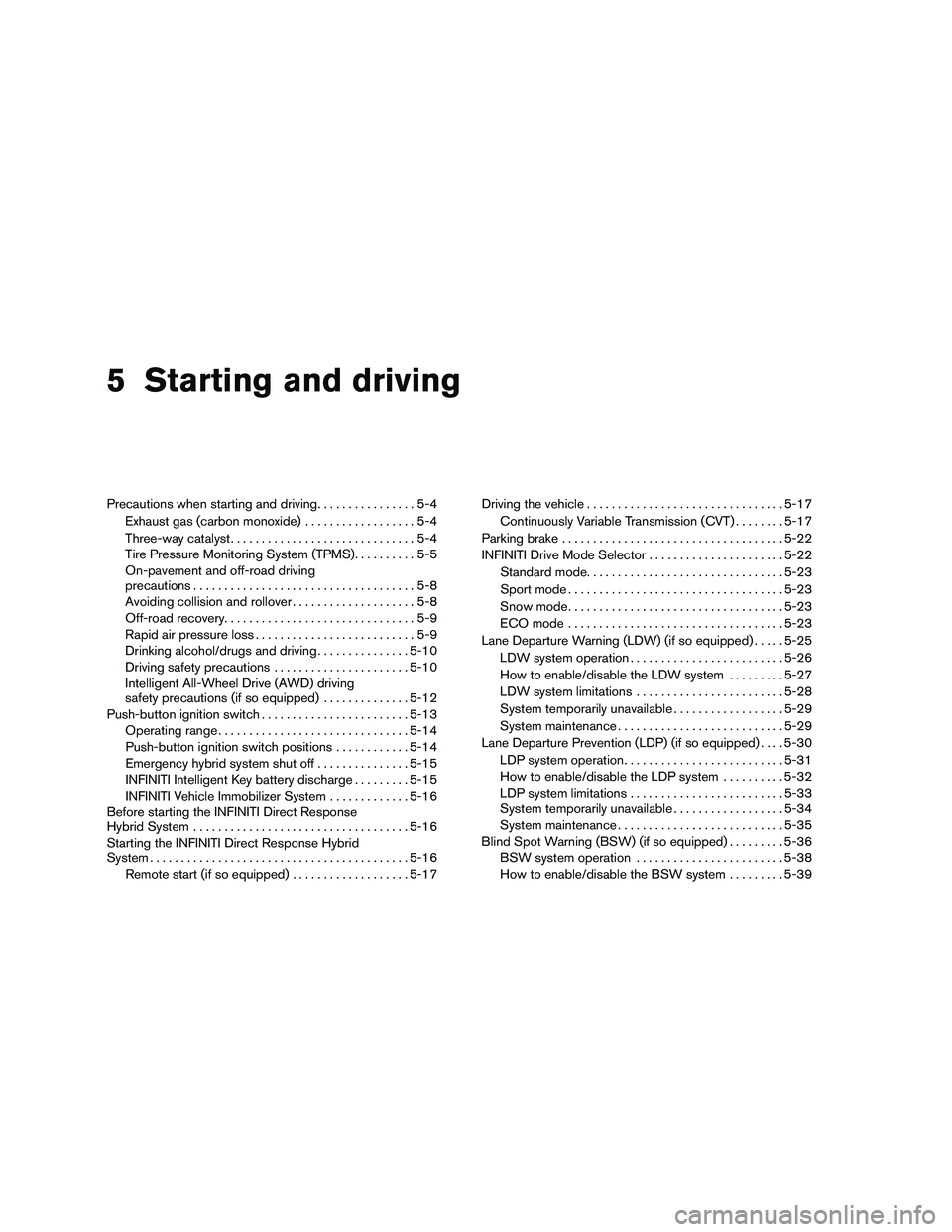
5 Starting and driving
Precautions when starting and driving................5-4
Exhaust gas (carbon monoxide) ..................5-4
Three-way catalyst ..............................5-4
Tire Pressure Monitoring System (TPMS) ..........5-5
On-pavement and off-road driving
precautions ....................................5-8
Avoiding collision and rollover . . ..................5-8
Off-road recovery ...............................5-9
Rapid air pressure loss ..........................5-9
Drinking alcohol/drugs and driving ...............5-10
Driving safety precautions ......................5-10
Intelligent All-Wheel Drive (AWD) driving
safety precautions (if so equipped) ..............5-12
Push-button ignition switch ........................5-13
Operating range ............................... 5-14
Push-button ignition switch positions . . . .........5-14
Emergency hybrid system shut off ...............5-15
INFINITI Intelligent Key battery discharge .........5-15
INFINITI Vehicle Immobilizer System .............5-16
Before starting the INFINITI Direct Response
Hybrid System ................................... 5-16
Starting the INFINITI Direct Response Hybrid
System .......................................... 5-16
Remote start (if so equipped) ...................5-17Driving the vehicle
................................ 5-17
Continuously Variable Transmission (CVT) ........5-17
Parking brake .................................... 5-22
INFINITI Drive Mode Selector ......................5-22
Standard mode ................................ 5-23
Sport mode ................................... 5-23
Snow mode ................................... 5-23
ECO mode ................................... 5-23
Lane Departure Warning (LDW) (if so equipped) .....5-25
LDW system operation ......................... 5-26
How to enable/disable the LDW system .........5-27
LDW system limitations ........................ 5-28
System temporarily unavailable ..................5-29
System maintenance ........................... 5-29
Lane Departure Prevention (LDP) (if so equipped) ....5-30
LDP system operation .......................... 5-31
How to
enable/disable the LDP system ..........5-32
LDP system limitations ......................... 5-33
System temporarily unavailable ..................5-34
System maintenance ........................... 5-35
Blind Spot Warning (BSW) (if so equipped) .........5-36
BSW system operation ........................ 5-38
How to enable/disable the BSW system .........5-39
Page 366 of 623
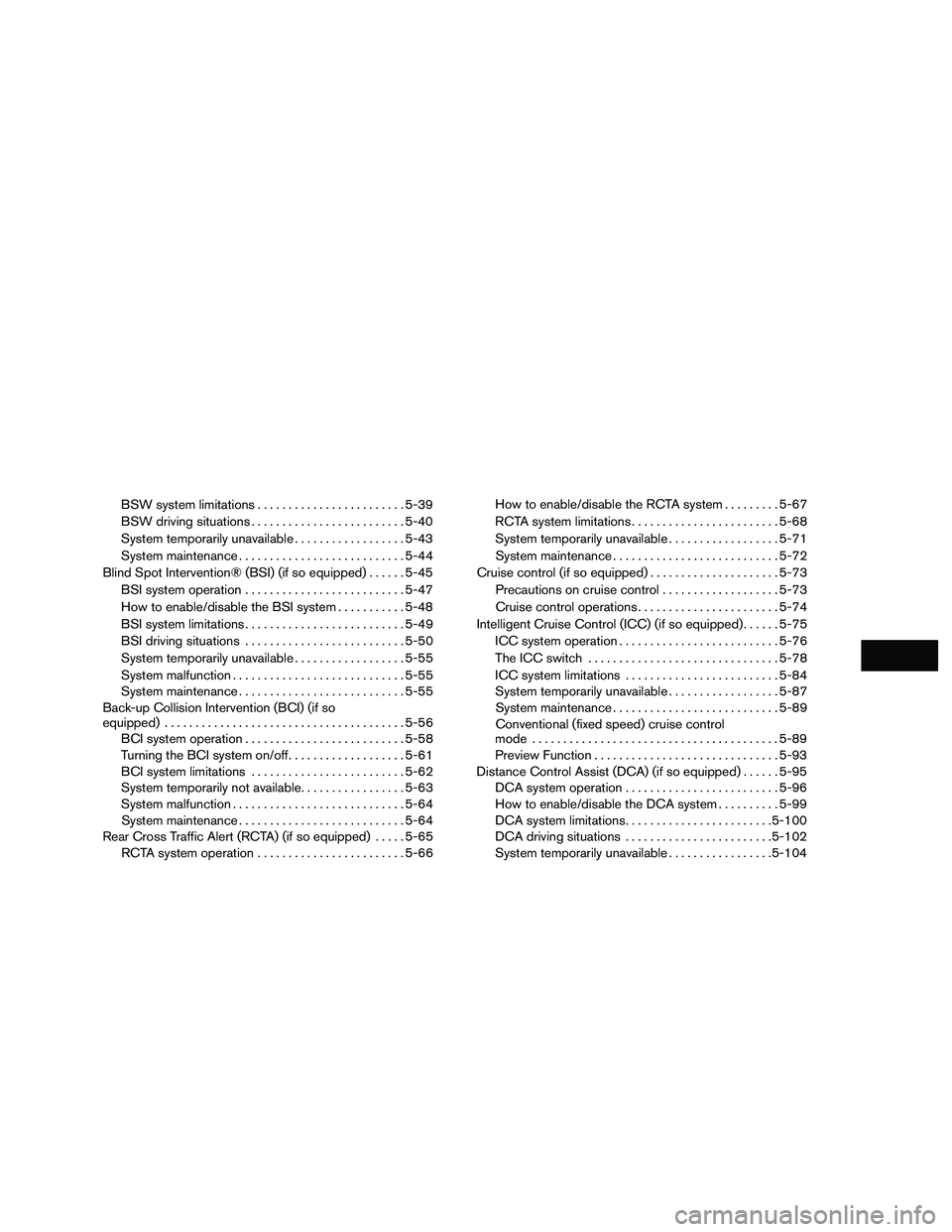
BSW system limitations........................ 5-39
BSW driving situations ......................... 5-40
System temporarily unavailable ..................5-43
System maintenance ........................... 5-44
Blind Spot Intervention® (BSI) (if so equipped) ......5-45
BSI system operation .......................... 5-47
How to enable/disable the BSI system ...........5-48
BSI system limitations .......................... 5-49
BSI driving situations .......................... 5-50
System temporarily unavailable ..................5-55
System malfunction ............................ 5-55
System maintenance ........................... 5-55
Back-up Collision Intervention (BCI) (if so
equipped) ....................................... 5-56
BCI system operation .......................... 5-58
Turning the BCI system on/off ...................5-61
BCI system limitations ......................... 5-62
System temporarily not available .................5-63
System malfunction ............................ 5-64
System maintenance ........................... 5-64
Rear Cross Traffic Alert (RCTA) (if so equipped) .....5-65
RCTA system operation ........................ 5-66How to enable/disable the RCTA system .
........5-67
RCTA system limitations ........................ 5-68
System temporarily unavailable ..................5-71
System maintenance ........................... 5-72
Cruise control (if so equipped) .....................5-73
Precautions on cruise control . ..................5-73
Cruise control operations .......................5-74
Intelligent Cruise Control (ICC) (if so equipped) ......5-75
ICC system operation .......................... 5-76
The ICC switch ............................... 5-78
ICC system limitations ......................... 5-84
System temporarily unavailable ..................5-87
System maintenance ........................... 5-89
Conventional (fixed
speed) cruise control
mode ........................................ 5-89
Preview Function .............................. 5-93
Distance Control Assist (DCA) (if so equipped) ......5-95
DCA system operation ......................... 5-96
How to enable/disable the DCA system ..........5-99
DCA system limitations ........................ 5-100
DCA driving situations ........................ 5-102
System temporarily unavailable .................5-104
Page 367 of 623
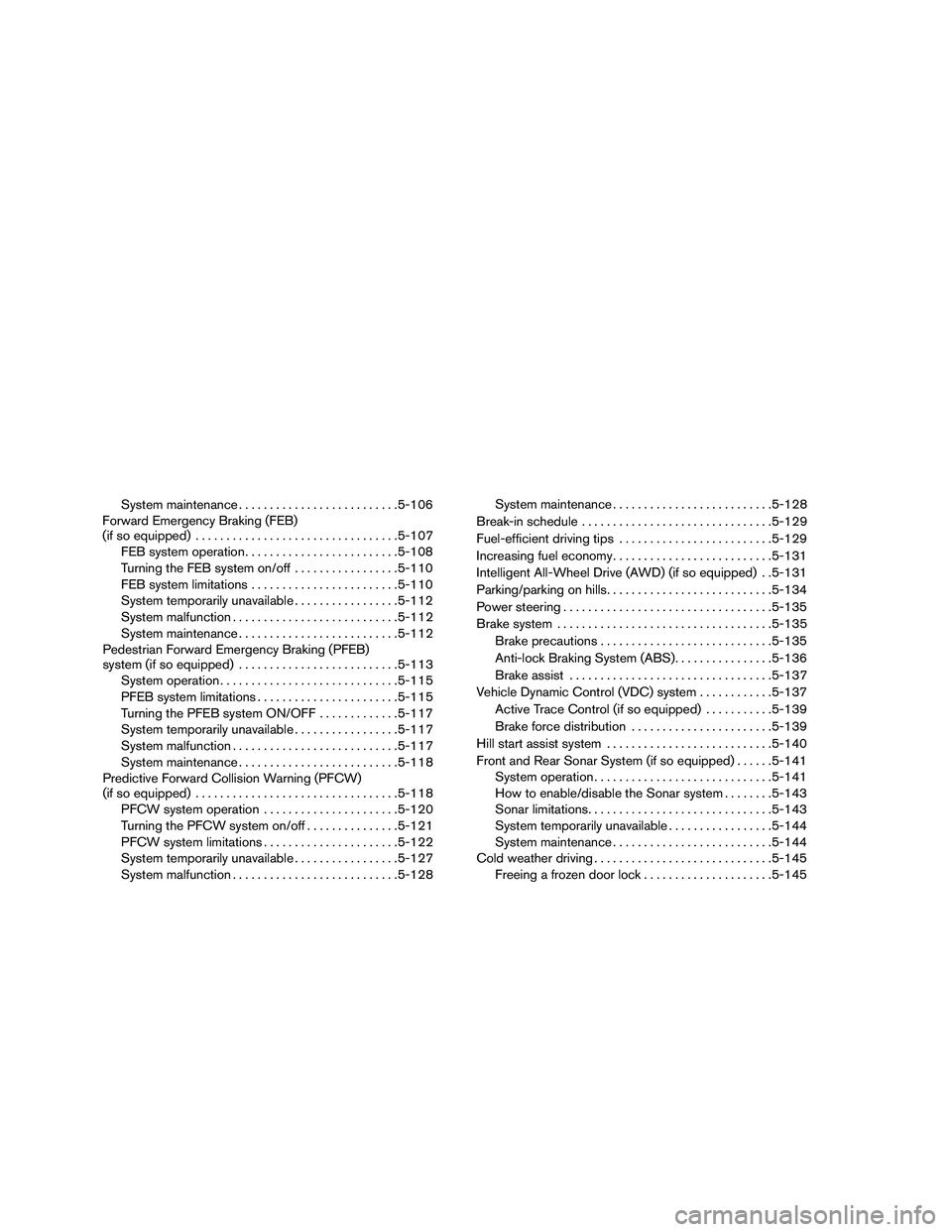
System maintenance.......................... 5-106
Forward Emergency Braking (FEB)
(if so equipped) ................................. 5-107
FEB system operation ......................... 5-108
Turning the FEB system on/off . . ...............5-110
FEB system limitations ........................ 5-110
System temporarily unavailable .................5-112
System malfunction ........................... 5-112
System maintenance .......................... 5-112
Pedestrian Forward Emergency Braking (PFEB)
system (if so equipped) .......................... 5-113
System operation ............................. 5-115
PFEB system limitations ....................... 5-115
Turning the PFEB system ON/OFF .............5-117
System temporarily unavailable .................5-117
System malfunction ........................... 5-117
System maintenance .......................... 5-118
Predictive Forward Collision Warning (PFCW)
(if so equipped) ................................. 5-118
PFCW system operation ......................5-120
Turning the PFCW system on/off ...............5-121
PFCW system limitations ......................5-122
System temporarily unavailable .................5-127
System malfunction ........................... 5-128System maintenance
.......................... 5-128
Break-in schedule ............................... 5-129
Fuel-efficient driving tips ......................... 5-129
Increasing fuel economy .......................... 5-131
Intelligent All-Wheel Drive (AWD) (if so equipped) . .5-131
Parking/parking on hills ........................... 5-134
Power steering .................................. 5-135
Brake system ................................... 5-135
Brake precautions ............................ 5-135
Anti-lock Braking System (ABS) ................5-136
Brake assist ................................. 5-137
Vehicle Dynamic Control (VDC) system ............5-137
Active Trace Control (if so equipped) ...........5-139
Brake force
distribution ....................... 5-139
Hill start assist system ........................... 5-140
Front and Rear Sonar System (if so equipped) ......5-141
System operation ............................. 5-141
How to enable/disable the Sonar system . .......5-143
Sonar limitations .............................. 5-143
System temporarily unavailable .................5-144
System maintenance .......................... 5-144
Cold weather driving ............................. 5-145
Freeing a frozen door lock .....................5-145
Page 368 of 623
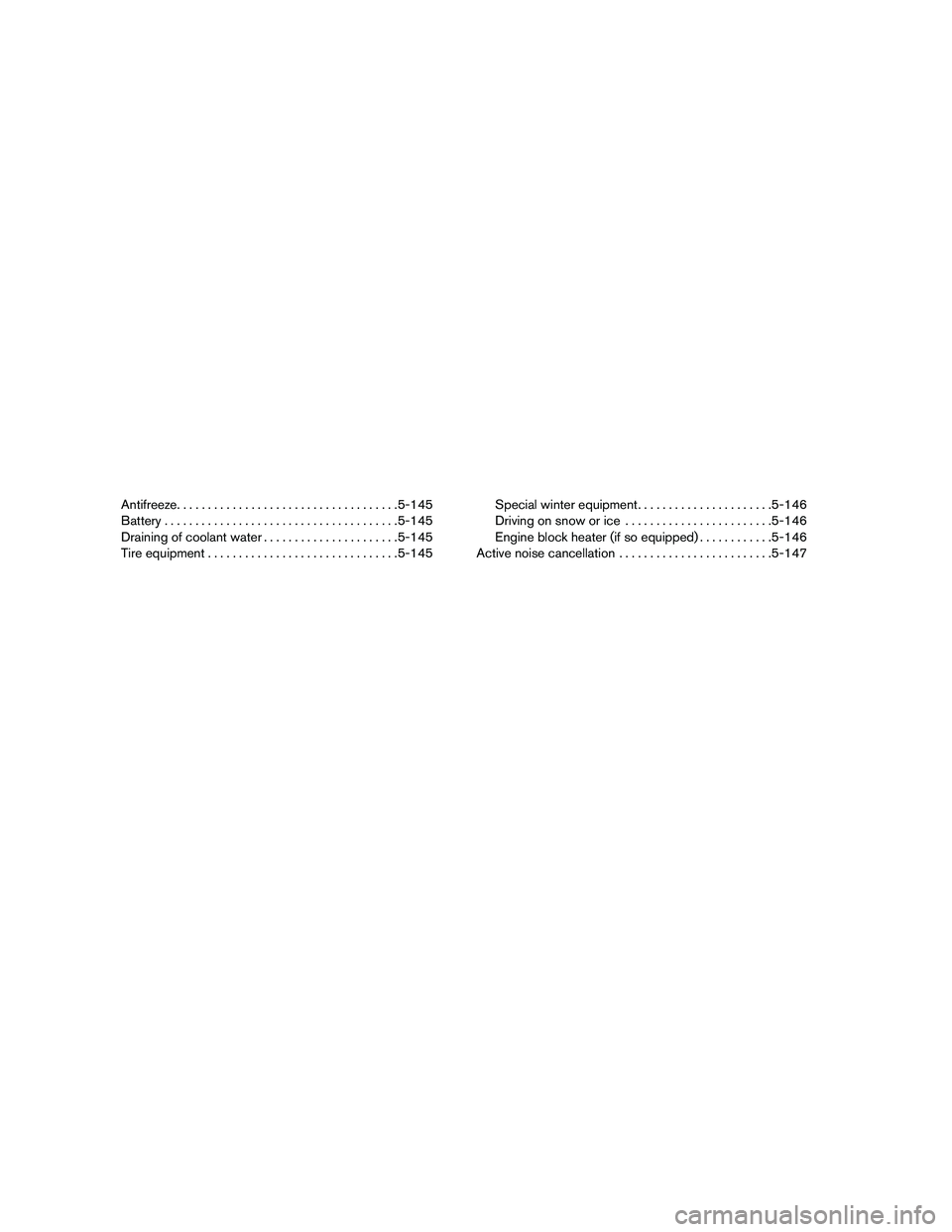
Antifreeze.................................... 5-145
Battery ...................................... 5-145
Draining of coolant water ......................5-145
Tire equipment ............................... 5-145Special winter equipment
......................5-146
Driving on snow or ice ........................ 5-146
Engine block heater (if so equipped) ............5-146
Active noise cancellation ......................... 5-147
Page 369 of 623
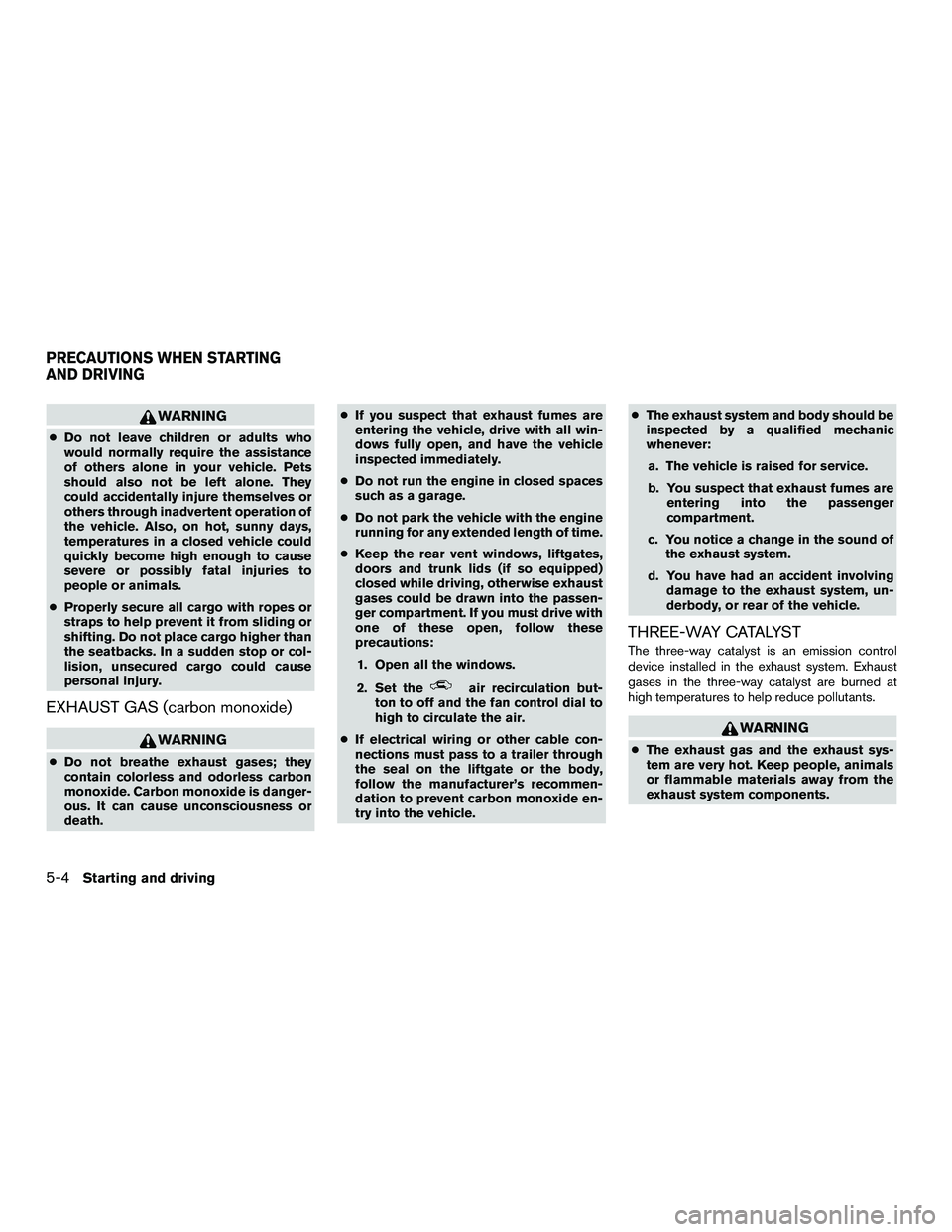
WARNING
●Do not leave children or adults who
would normally require the assistance
of others alone in your vehicle. Pets
should also not be left alone. They
could accidentally injure themselves or
others through inadvertent operation of
the vehicle. Also, on hot, sunny days,
temperatures in a closed vehicle could
quickly become high enough to cause
severe or possibly fatal injuries to
people or animals.
● Properly secure all cargo with ropes or
straps to help prevent it from sliding or
shifting. Do not place cargo higher than
the seatbacks. In a sudden stop or col-
lision, unsecured cargo could cause
personal injury.
EXHAUST GAS (carbon monoxide)
WARNING
●Do not breathe exhaust gases; they
contain colorless and odorless carbon
monoxide. Carbon monoxide is danger-
ous. It can cause unconsciousness or
death. ●
If you suspect that exhaust fumes are
entering the vehicle, drive with all win-
dows fully open, and have the vehicle
inspected immediately.
● Do not run the engine in closed spaces
such as a garage.
● Do not park the vehicle with the engine
running for any extended length of time.
● Keep the rear vent windows, liftgates,
doors and trunk lids (if so equipped)
closed while driving, otherwise exhaust
gases could be drawn into the passen-
ger compartment. If you must drive with
one of these open, follow these
precautions:
1. Open all the windows.
2. Set the
air recirculation but-
ton to off and the fan control dial to
high to circulate the air.
● If electrical wiring or other cable con-
nections must pass to a trailer through
the seal on the liftgate or the body,
follow the manufacturer’s recommen-
dation to prevent carbon monoxide en-
try into the vehicle. ●
The exhaust system and body should be
inspected by a qualified mechanic
whenever:
a. The vehicle is raised for service.
b. You suspect that exhaust fumes are entering into the passenger
compartment.
c. You notice a change in the sound of the exhaust system.
d. You have had an accident involving damage to the exhaust system, un-
derbody, or rear of the vehicle.
THREE-WAY CATALYST
The three-way catalyst is an emission control
device installed in the exhaust system. Exhaust
gases in the three-way catalyst are burned at
high temperatures to help reduce pollutants.
WARNING
●The exhaust gas and the exhaust sys-
tem are very hot. Keep people, animals
or flammable materials away from the
exhaust system components.
PRECAUTIONS WHEN STARTING
AND DRIVING
5-4Starting and driving
Page 370 of 623
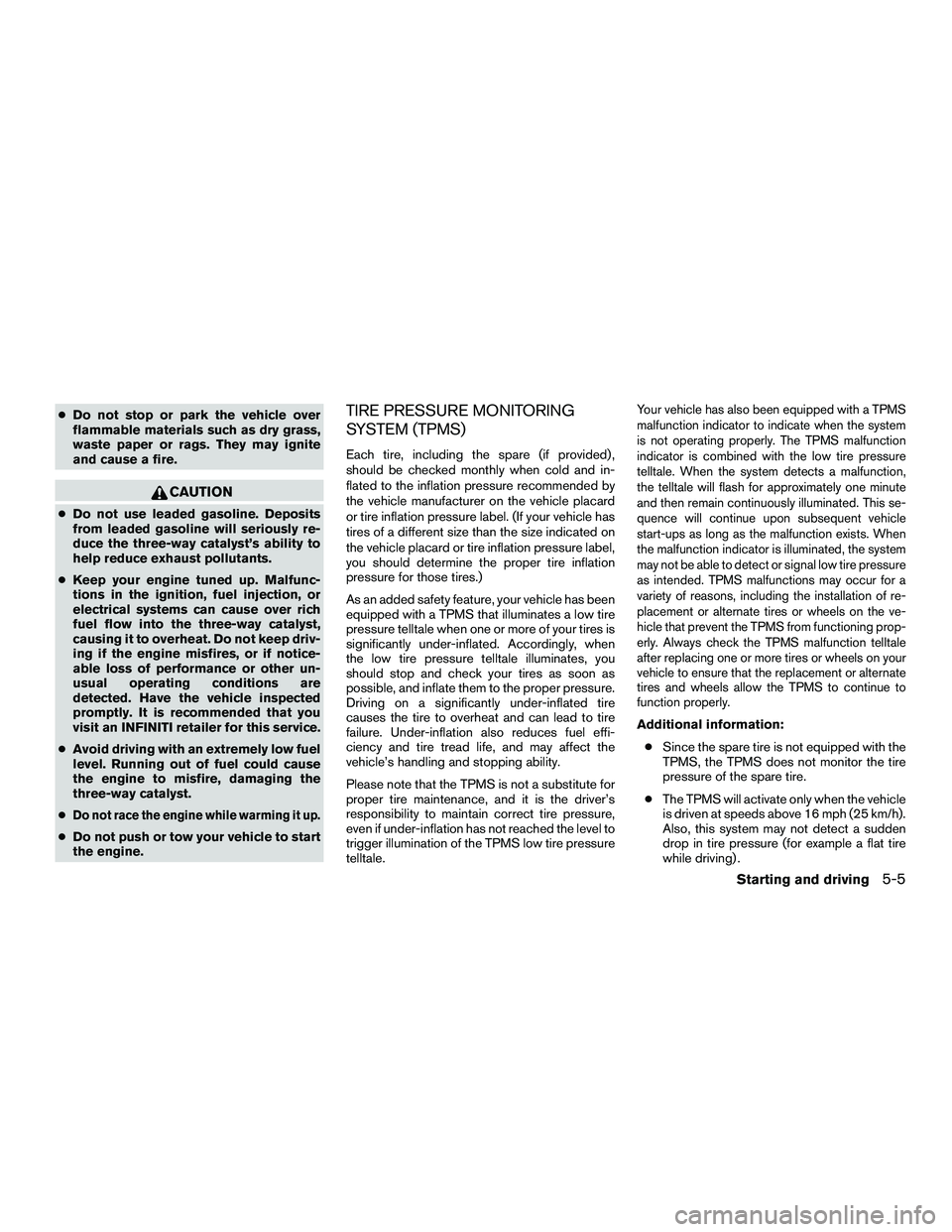
●Do not stop or park the vehicle over
flammable materials such as dry grass,
waste paper or rags. They may ignite
and cause a fire.
CAUTION
●Do not use leaded gasoline. Deposits
from leaded gasoline will seriously re-
duce the three-way catalyst’s ability to
help reduce exhaust pollutants.
● Keep your engine tuned up. Malfunc-
tions in the ignition, fuel injection, or
electrical systems can cause over rich
fuel flow into the three-way catalyst,
causing it to overheat. Do not keep driv-
ing if the engine misfires, or if notice-
able loss of performance or other un-
usual operating conditions are
detected. Have the vehicle inspected
promptly. It is recommended that you
visit an INFINITI retailer for this service.
● Avoid driving with an extremely low fuel
level. Running out of fuel could cause
the engine to misfire, damaging the
three-way catalyst.
●
Do not race the engine while warming it up.
● Do not push or tow your vehicle to start
the engine.
TIRE PRESSURE MONITORING
SYSTEM (TPMS)
Each tire, including the spare (if provided) ,
should be checked monthly when cold and in-
flated to the inflation pressure recommended by
the vehicle manufacturer on the vehicle placard
or tire inflation pressure label. (If your vehicle has
tires of a different size than the size indicated on
the vehicle placard or tire inflation pressure label,
you should determine the proper tire inflation
pressure for those tires.)
As an added safety feature, your vehicle has been
equipped with a TPMS that illuminates a low tire
pressure telltale when one or more of your tires is
significantly under-inflated. Accordingly, when
the low tire pressure telltale illuminates, you
should stop and check your tires as soon as
possible, and inflate them to the proper pressure.
Driving on a significantly under-inflated tire
causes the tire to overheat and can lead to tire
failure. Under-inflation also reduces fuel effi-
ciency and tire tread life, and may affect the
vehicle’s handling and stopping ability.
Please note that the TPMS is not a substitute for
proper tire maintenance, and it is the driver’s
responsibility to maintain correct tire pressure,
even if under-inflation has not reached the level to
trigger illumination of the TPMS low tire pressure
telltale.
Your vehicle has also been equipped with a TPMS
malfunction indicator to indicate when the system
is not operating properly. The TPMS malfunction
indicator is combined with the low tire pressure
telltale. When the system detects a malfunction,
the telltale will flash for approximately one minute
and then remain continuously illuminated. This se-
quence will continue upon subsequent vehicle
start-ups as long as the malfunction exists. When
the malfunction indicator is illuminated, the system
may not be able to detect or signal low tire pressure
as intended. TPMS malfunctions may occur for a
variety of reasons, including the installation of re-
placement or alternate tires or wheels on the ve-
hicle that prevent the TPMS from functioning prop-
erly. Always check the TPMS malfunction telltale
after replacing one or more tires or wheels on your
vehicle to ensure that the replacement or alternate
tires and wheels allow the TPMS to continue to
function properly.
Additional information:
● Since the spare tire is not equipped with the
TPMS, the TPMS does not monitor the tire
pressure of the spare tire.
● The TPMS will activate only when the vehicle
is driven at speeds above 16 mph (25 km/h).
Also, this system may not detect a sudden
drop in tire pressure (for example a flat tire
while driving) .
Starting and driving5-5